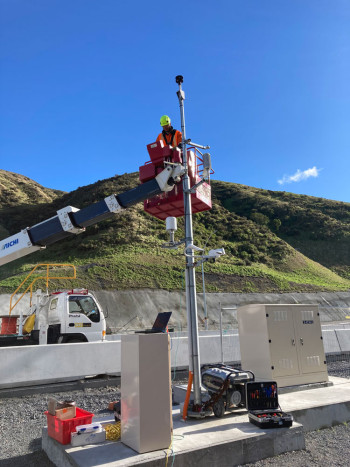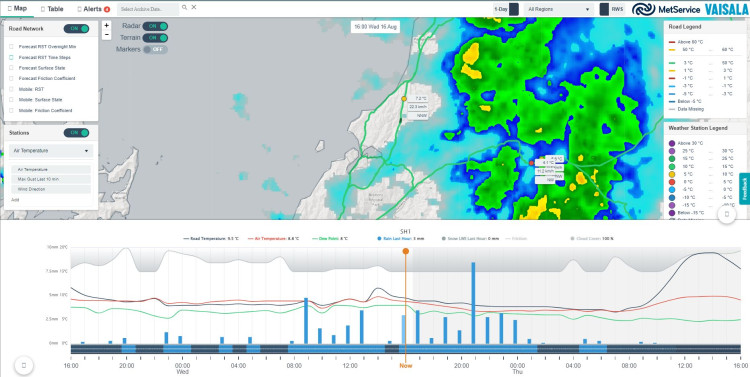MetService weather experts John Law and Peter Fisher share their excitement over the uniquely placed Transmission Gully weather station, how the readings help keep drivers safe, and why the weather will always be more than just small talk for them.

The weather station atop Pouāwhā - the Wainui Saddle.
The weather has always fascinated MetService meteorologist and broadcaster John Law, “One of my earliest memories from the UK was in 1987, there was a huge storm that ran across the South Coast of England, and it began my obsession with the weather.” This fascination led John to a worldwide travel career discussing the weather and installing weather stations.
“Every new weather station installation is exciting, and the one on the Transmission Gully motorway was no exception,” says John Law, MetService meteorologist.
Sitting atop Pouāwhā - the Wainui Saddle and approximately 260 metres above sea level, MetService’s Business Development Manager, Peter Fisher, explains this station contains the latest technology in weather reading, including “ultrasonic wind sensors,” which use sound waves to measure the speed and direction of the wind, and solar sensors to measure sunshine. There are only 50 of these modern road weather stations across the country, and Transmission Gully motorway’s station is one of only two in the Wellington region.
With over 200 weather stations across New Zealand, MetService uses these as one of their inputs to forecasts for the whole state highway network, automatically monitoring approximately 12,150 kilometres of road. Still, it’s the position of this weather station that continues to intrigue weather enthusiasts.
“You can’t beat on-the-ground observations. Installing a weather station on Transmission Gully was incredibly exciting because instead of utilising data modelling, we can also gather information every 60 seconds that could affect road users, for example, how cloud, visibility, rainfall, temperature and wind conditions are impacting the road at any one time,” says Peter.

The information captured in the system is fed back to the motorway operator Ventia and Waka Kotahi to help keep motorists safe.
There have been some notable weather conditions in the reporting data since installation in June 2021, including:
Maximum gust: 105km/h
Total rainfall: 920mm
Maximum temperature: 26.6⁰C
Minimum temperature: 0.5⁰C
Comparing this data with the weather station in Paraparaumu, the Wainui Saddle was not as warm; Paraparaumu reached 29.1⁰C, but also was not as cold; the minimum temperature in Paraparaumu was -2.5⁰C. Pouāwhā - the Saddle was a little windier, with the maximum wind at Paraparaumu reaching 111.1km/h (last Sunday).
Through MetService, Peter works with multiple sectors across New Zealand to design weather packages that meet the needs of mission-critical organisations.
Whether it's for the transport sector in helping to determine where to put de-icing agents on the road, aiding the energy sector to make informed buying and selling decisions regarding renewable energy products, or simply helping people know when to hang their clothes out on the washing line, Peter says weather information is essential for decision making.
“The weather is constantly changing; no one day is the same. We love being able to make a difference by providing weather intelligence which contributes to important deciding factors regarding safety and profitability; we are able to provide our customers assurance in their decision-making,” says Peter.
Peter’s enthusiasm for weather is equally as contagious as John’s, stemming from his interest as early as ten years old, collecting clippings from the newspaper and drawing his own weather graphs. He has dedicated the last 40 years of his life to his career in the weather industry, even managing a weather programme on a remote volcanic island, that housed only six people!
“Weather has the perfect mix of science, maths, art, and communication. You are taking complex weather models, breaking them down, and then communicating that into a format that helps people make the right decisions for what they want to do,” says Peter.
It’s clear that John and Peter love everything about the weather, and when asked if they ever get sick of small talk about the weather both replied: “Never.” “But I’m sure my friends do!” John adds.
“More frequent and potentially stronger westerly wind scenarios, could lead to blustery conditions and a higher occurrence of reduced visibility at the top of the Wainui Saddle for the springtime. Well worth keeping an eye on the forecast when planning your journeys,” says John.
Explanation: As meteorologists, we often look far beyond New Zealand to help guide us for the upcoming seasons. One thing we look at closely is the El Niño Southern Oscillation. This assesses the atmospheric and marine conditions around the equatorial Pacific.
For the last three years, the ENSO has been under a La Niña phase, which for New Zealand has resulted in more frequent weather systems arriving from the northwest, bringing wetter and warmer conditions to the North Island. However, this year we are already starting to see indications of a change in pattern to the El Niño phase. Under these conditions, we tend to find windier springtime conditions for us here in Wellington.
Wellington is known for being a windy city, and this is partly due to the topography of the region. In New Zealand, our predominant wind direction is from the west. Wind behaves a bit like water and finds the path of least resistance as it moves across the country, and so is forced to squeeze through the Cook Strait by the mountains of the South Island and the ridge of mountains in the east of our region.
The winds over the saddle work similarly, being funnelled over the top of the hill by the cuttings on either side of the road, so watch out for some stronger winds at the top of the road when driving.
The main takeaway for drivers is to drive to the conditions!